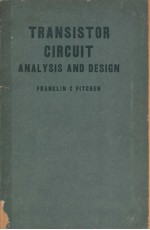

TRANSISTOR CIRCUIT ANALYSIS AND DESIGNPDF电子书下载
- 电子书积分:13 积分如何计算积分?
- 作 者:FRANKLIN C.FITCHEN
- 出 版 社:
- 出版年份:2222
- ISBN:
- 页数:356 页
1.INTRODUCTION TO THE TRANSISTOR 1
1-1 Semiconductors 2
1-2 Diodes 3
1-3 Transistors 4
1-4 Symbols 6
1-5 Graphical Characteristics 7
1-6 The Operating Point 10
1-7 Amplification 11
1-8 Leakage Currents 14
1-9 Saturation and Cutoff Regions 15
1-10 Summary 17
2.SEMICONDUCTOR PHYSICS 20
2-1 Structure 20
2-2 Impurities 21
2-3 Energy-Level Diagrams 24
2-4 p-n Junctions 26
2-5 Transistor Operation 29
2-6 Transistor Fabrication 32
2-7 Other Transistor Types 33
2-8 Operation at High Frequencies 34
2-9 Metallic Contact Devices 36
2-10 Switching Devices 37
2-11 Allied Semiconductor Devices 39
3.THE OPERATING POINT 43
3-1 Bias Stability 44
3-2 Variations 45
3-3 Circuit Studies 47
3-4 Fixed Bias 49
3-5 Single-Battery Bias 52
3-6 Emitter Bias 54
3-7 Self Bias 56
3-8 Cutoff Bias 58
3-9 Other Means of Setting the Operating Point 58
3-10 Drawing the Load Line 59
3-11 Design of Biasing Circuitry 61
3-12 Summary 63
4.EQUIVALENT CIRCUITS AND THEIR PARAMETERS 69
4-1 Equivalent Circuits 69
4-2 Current-Generator Equivalent Tee 71
4-3 Matrix Parameters 80
4-4 The Hybrid Equivalent Circuit 81
4-5 Parameters 90
4-6 Comparison of Configurations 97
4-7 Stabilization of Gain 100
4-8 Gain Considerations 102
4-9 Examples of Single-Stage Calculations 104
4-10 Instantaneous Analysis 107
4-11 Summary 109
5.SINGLE-STAGE AMPLIFIER DESIGN 114
5-1 Choice of a Transistor 114
5-2 Coupling 116
5-3 High-Frequency Considerations 122
5-4 Load Lines 129
5-5 Design of Single-Stage Low-Power Amplifiers 131
5-6 Effects of the Operating Point upon Gain 136
5-7 Summary 137
6.LARGE-SIGNAL AMPLIFIERS 141
6-1 Limitations 141
6-2 Thermal Considerations 143
6-3 Large-signal Parameters 147
6-4 Modes and Configurations 148
6-5 Distortion 149
6-6 Class-A Amplification 151
6-7 Shifting of the Operating Point 154
6-8 Class-B Amplification 155
6-9 Phase Inverters 158
6-10 Summary 161
7.MULTISTAGE AMPLIFJERS 165
7-1 Analysis by Blocks 165
7-2 Analysis by Kirchhoff’s Laws 168
7-3 Analysis by h-Parameters 169
7-4 Design of Multistage Amplifiers 171
8.FEEDBACK 188
8-1 Feedback—General Theory 188
8-2 Local Feedback 195
8-3 Multistage Feedback 199
8-4 Automatic Gain Control 206
8-5 Direct-Coupled Amplifiers 209
9.COMMUNICATIONS AMPLIFIERS 226
9-1 Noise 226
9-2 Volume Control 231
9-3 Shaping of the Frequency Response 233
9-4 High-Frequency Performance 237
9-5 The Video Amplifier 244
9-6 Tuned-Circuit Theory 246
9-7 Tuned Amplifiers 252
9-8 Instability of Tuned Amplifiers 255
9-9 Tuned Amplifier Design 257
10.COMMUNICATIONS CIRCUITS AND SYSTEMS 270
10-1 Oscillation 270
10-2 Modulation 281
10-3 Detection 285
10-4 Conversion and Mixing 289
10-5 The AM Receiver 291
10-6 The FM Receiver 292
11.PULSE CIRCUITS 304
11-1 Switching 304
11-2 Pulse Amplifiers 314
11-3 Multivibrators 315
APPENDICES 325
Ⅰ.Selected Transistor Data 325
Ⅱ.Parameter Conversions 342
Ⅲ.NBS Preferred Circuit No.201 Silicon Transistor Video Amplifier 344
INDEX 350
- 《经济学人权威预测:2050趋势巨流》丹尼尔·富兰克林(DANIEL FRANKLIN),约翰·安德鲁斯(JOHN ANDREWS)编著;罗耀宗译 2012
- 《本杰明·富兰克林自传》(美)富兰克林(Franklin,B.)著;(美)沙莱特(Shalett,A.)改写 张耘注释 1982
- 《国际市场进入战略 增订版》富兰克林·R·鲁特(Franklin R. Root)著;古玲香译 2005
- 《拥抱富兰克林 文学精华》(美)班杰明·富兰克林(Benjamin Franklin)著;张星等译 2000
- 《富兰克林自传》(美)本杰明·富兰克林(Benjamin Franklin)著;唐长孺译 2005
- 《富兰克林自传》(美)富兰克林(Franklin,B.)著;张勇,汝敏译 2006
- 《我的奋斗 本杰明·富兰克林成长自传》(美)本杰明·富兰克林(Benjamin Franklin)著;万绍红译 2006
- 《国际行销管理学》Franklin R.Root原著;杨介中译 1983
- 《舞蹈意象与身体训练》Eric Franklin著 2007
- 《富兰克林格言集 英汉对照》(美)富兰克林(Benjamin Franklin)著;施茵编译 1997
